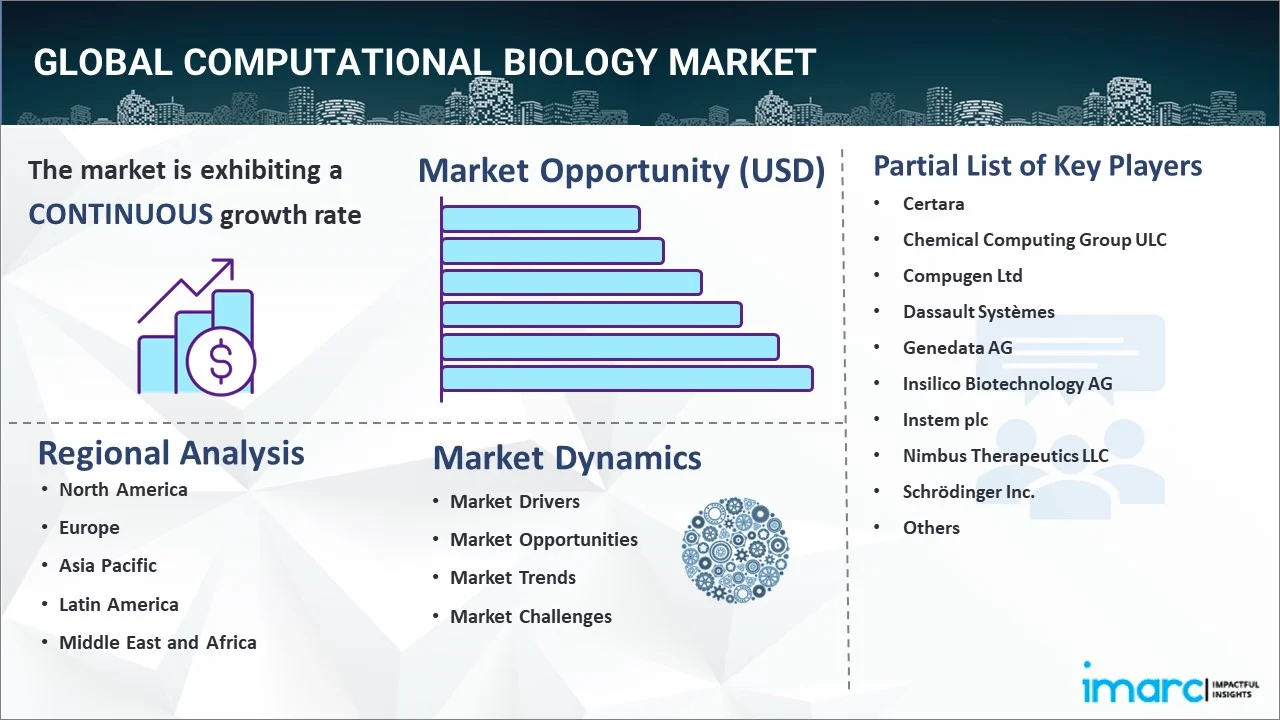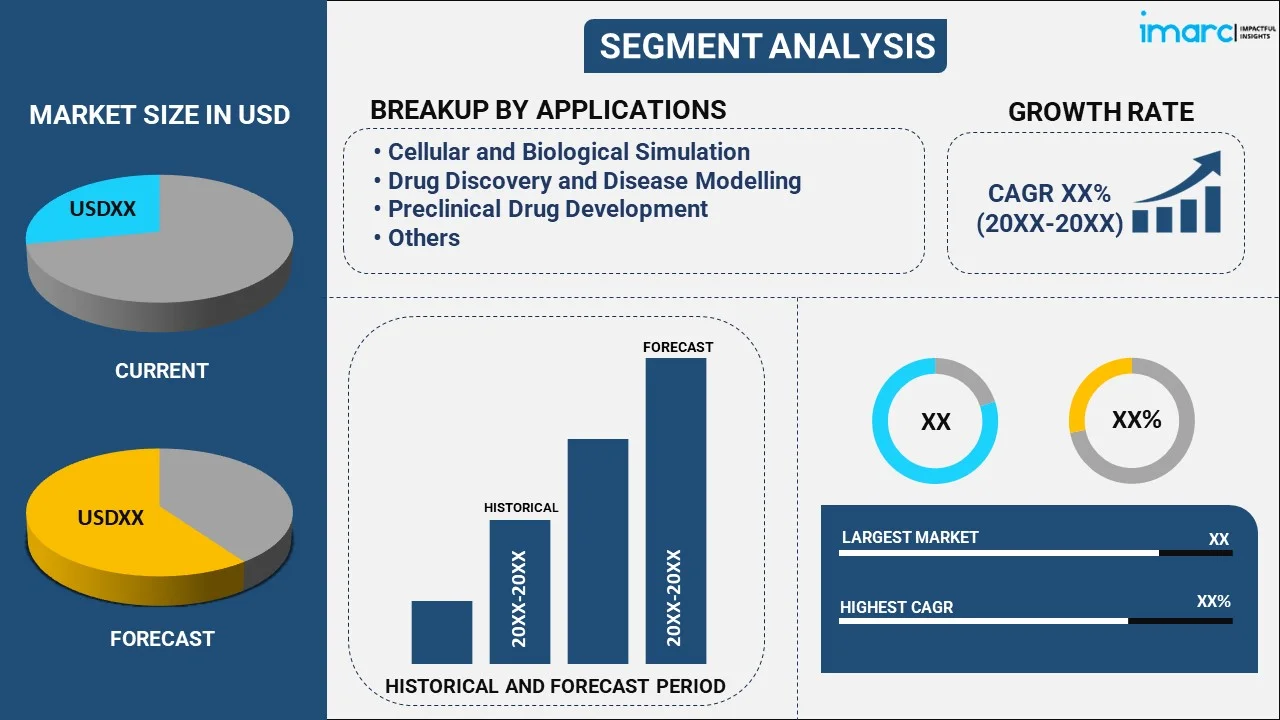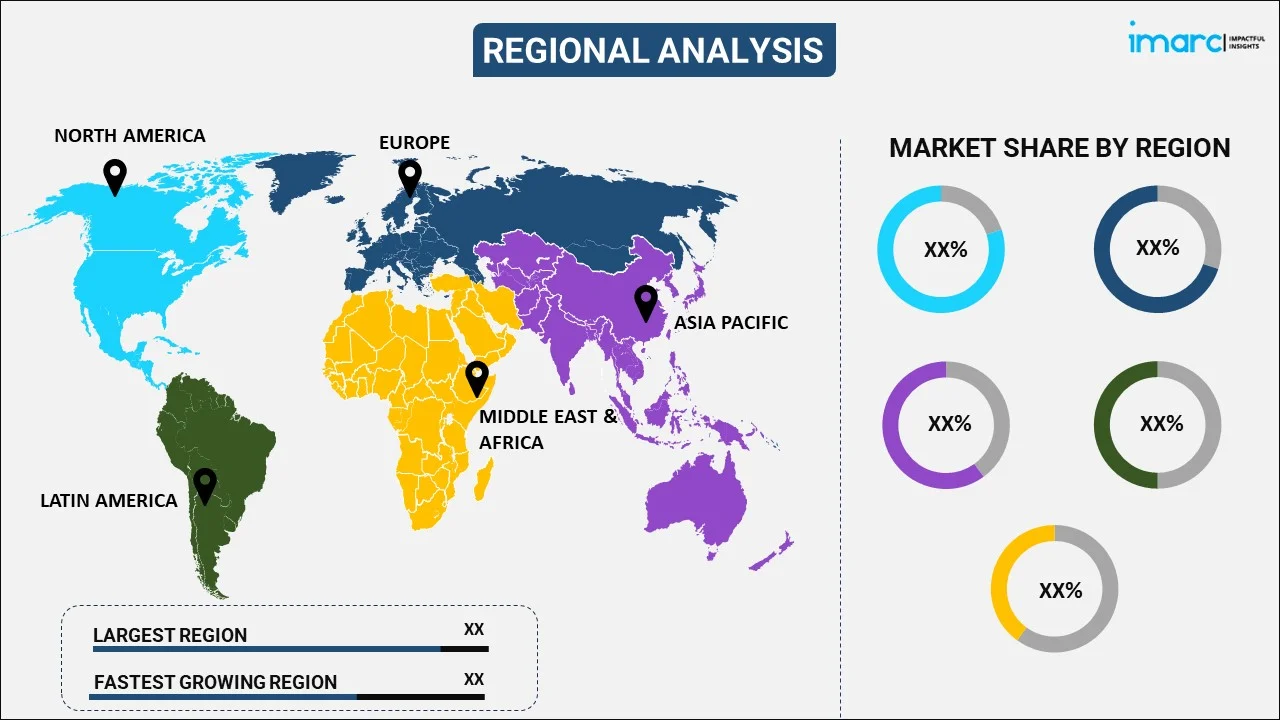
Computational Biology Market Report by Application (Cellular and Biological Simulation, Drug Discovery and Disease Modelling, Preclinical Drug Development, Clinical Trials, Human Body Simulation Software), Services (In-House, Contract), End Use (Academics, Pharmaceutical Industry, Commercial), and Region 2025-2033
Computational Biology Industry Overview:
The global computational biology market size reached USD 6.8 Billion in 2024. Looking forward, IMARC Group expects the market to reach USD 32.2 Billion by 2033, exhibiting a growth rate (CAGR) of 17.83% during 2025-2033. The market is being driven by the rising number of clinical studies, along with integration of advanced technologies. At present, North America holds the largest market share, driven by the presence of leading pharmaceutical and biotechnology companies and various collaborations among companies.
|
Report Attribute
|
Key Statistics
|
|---|---|
|
Base Year
|
2024
|
|
Forecast Years
|
2025-2033
|
|
Historical Years
|
2019-2024
|
|
Market Size in 2024
|
USD 6.8 Billion |
|
Market Forecast in 2033
|
USD 32.2 Billion |
| Market Growth Rate 2025-2033 | 17.83% |
Computational biology, also known as bioinformatics, is the interdisciplinary branch of science that uses math, statistics and computer science for understanding and modeling the structures and processes of life. It involves various aspects of biology, such as genetics, evolution, cell biology, and biochemistry. The process uses computational techniques, including algorithms, to represent and simulate biological systems and interpret experimental data on a large scale. Computational biology also helps understand the treatment for diseases and cellular function by creating a database of biological information from amino-acid sequences, nucleotides, and macromolecular structures. Nowadays, computational biology has become an essential part of biological research projects, including the human genome project, protein data banks and genomic databases.

Computational Biology Market Trends:
The global computational biology market is primarily driven by the rising number of clinical studies in the field of pharmacogenomics. This has helped increase the understanding of the diverse biological makeup of the patient population, biological pathways, and the genomes underpinning them. As a result, there is a high demand for computational biology solutions, as they help reduce the overall time needed for drug discovery and various other scientific experiments. The process also aids the visualization of tools to simulate advanced drug-drug interactions. In addition to this, the growing demand for computational biology in epi-genomics, proteomics, and meta-genomics to undertint protein structures and interactions is also propelling the market growth. Furthermore, various technological advancements in drug development and disease modeling, along with increasing investments by private and government organizations in research and development (R&D) activities, are also anticipated to provide a positive thrust to the market in the near future.
Key Market Segmentation:
IMARC Group provides an analysis of the key trends in each sub-segment of the global computational biology market report, along with forecasts at the global, regional and country level from 2025-2033. Our report has categorized the market based on application, services and end use.
Breakup by Application:

- Cellular and Biological Simulation
- Computational Genomics
- Computational Proteomics
- Pharmacogenomics
- Others
- Drug Discovery and Disease Modelling
- Target Identification
- Target Validation
- Lead Discovery
- Lead Optimization
- Preclinical Drug Development
- Pharmacokinetics
- Pharmacodynamics
- Clinical Trials
- Phase I
- Phase II
- Phase III
- Human Body Simulation Software
Cellular and biological simulation accounts for the majority of the market share
The report has provided a detailed breakup and analysis of the market based on the application. This includes cellular and biological simulation (computational genomics, computational proteomics, pharmacogenomics, and others), drug discovery and disease modelling (target identification, target validation, lead discovery, and lead optimization), preclinical drug development (pharmacokinetics and pharmacodynamics), clinical trials (phase I, phase II, and phase III), and human body simulation software. According to the report, cellular and biological simulation represented the largest segment.
Researchers can better comprehend basic biological processes and the course of disease by using cellular and biological modeling. Cellular simulations are essential to drug discovery because they allow for virtual chemical screening, drug interaction prediction, and lead candidate optimization. As a result, this reduces the time and cost associated with traditional experimental approaches. The accuracy and dependability of cellular and biological simulations are improved by the development of complex simulation software and algorithms such as agent-based modeling and systems biology techniques. A thorough grasp of biological activities is made possible by the integration of simulations with proteomic, metabolomic, and genomic data.
Breakup by Services:
- In-house
- Contract
Contract holds the largest share of the industry
A detailed breakup and analysis of the market based on the services have also been provided in the report. This includes in-house and contract. According to the report, contract accounts for the largest market share.
Contract services provide cost-effective solutions compared to maintaining in-house capabilities, particularly for smaller companies or those with limited resources. This trend is fostering more organizations to engage third-party providers for computational biology services. Contract service providers usually have access to the latest computational tools, technologies, and methodologies that allow clients to benefit from state-of-the-art solutions without the need for significant investment in infrastructure. Furthermore, contract services offer flexibility and scalability that allow companies to adjust the level of support based on project requirements.
Breakup by End Use:
- Academics
- Pharmaceutical Industry
- Commercial
Commercial represents the leading market segment
The report has provided a detailed breakup and analysis of the market based on the end use. This includes academics, pharmaceutical industry, and commercial. According to the report, commercial represents the largest segment.
The creation of novel treatments is becoming a top priority for commercial enterprises, necessitating the use of sophisticated computational tools for biological system modeling, medication interaction prediction, and data analysis. The commercial segment is growing as a result of pharmaceutical and biotechnology businesses' substantial spending in research and development (R&D) activities. Computational biology solutions are being used by businesses more and more in order to obtain a competitive edge in drug discovery. The integration of data science and machine learning (ML) into drug development processes is leading to a higher adoption of computational biology techniques in commercial settings.
Breakup by Region:

- North America
- United States
- Canada
- Asia-Pacific
- China
- Japan
- India
- South Korea
- Australia
- Indonesia
- Others
- Europe
- Germany
- France
- United Kingdom
- Italy
- Spain
- Russia
- Others
- Latin America
- Brazil
- Mexico
- Others
- Middle East and Africa
North America leads the market, accounting for the largest computational biology market share
The report has also provided a comprehensive analysis of all the major regional markets, which include North America (the United States and Canada); Asia Pacific (China, Japan, India, South Korea, Australia, Indonesia, and others); Europe (Germany, France, the United Kingdom, Italy, Spain, Russia, and others); Latin America (Brazil, Mexico, and others); and the Middle East and Africa. According to the report, North America represents the largest regional market for computational biology.
North America is home to many leading pharmaceutical and biotechnology companies. The demand for computational biology solutions is significant in this region, as companies seek to streamline drug discovery and enhance their research and development (R&D) processes. The presence of well-established research institutions, universities, and laboratories equipped with advanced technologies fosters a conducive environment for computational biology. These institutions often collaborate with commercial entities, further driving the demand for computational services. Furthermore, top players in the region are developing new tools and methodologies that enhance research capabilities.
Competitive Landscape:
The competitive landscape of the industry has also been examined along with the profiles of the key players being Certara, Chemical Computing Group ULC, Compugen Ltd, Dassault Systèmes, Genedata AG, Insilico Biotechnology AG, Instem plc, Nimbus Therapeutics LLC, Schrödinger Inc. and Simulations Plus Inc.
Report Coverage:
| Report Features | Details |
|---|---|
| Base Year of the Analysis | 2024 |
| Historical Period | 2019-2024 |
| Forecast Period | 2025-2033 |
| Units | Billion USD |
| Segment Coverage | Application, Services, End Use, Region |
| Region Covered | Asia Pacific, Europe, North America, Latin America, Middle East and Africa |
| Countries Covered | United States, Canada, Germany, France, United Kingdom, Italy, Spain, Russia, China, Japan, India, South Korea, Australia, Indonesia, Brazil, Mexico |
| Companies Covered | Certara, Chemical Computing Group ULC, Compugen Ltd, Dassault Systèmes, Genedata AG, Insilico Biotechnology AG, Instem plc, Nimbus Therapeutics LLC, Schrödinger Inc. and Simulations Plus Inc. |
| Customization Scope | 10% Free Customization |
| Post-Sale Analyst Support | 10-12 Weeks |
| Delivery Format | PDF and Excel through Email (We can also provide the editable version of the report in PPT/Word format on special request) |
Key Questions Answered in This Report
The global computational biology market was valued at USD 6.8 Billion in 2024.
We expect the global computational biology market to exhibit a CAGR of 17.83% during 2025-2033.
The rising demand for computational biology solutions, to reduce the overall time required for drug discovery and numerous other scientific experiments, is primarily driving the global computational biology market.
The sudden outbreak of the COVID-19 has led to the increasing demand for computational biology to understand the viral pathogenic mechanism and propose novel therapeutic techniques, for identifying safe and effective remedial solutions to treat the coronavirus infection.
Based on the application, the global computational biology market can be segmented into cellular and biological simulation, drug discovery and disease modelling, preclinical drug development, clinical trials, and human body simulation software. Among these, cellular and biological simulation currently holds the majority of the total market share.
Based on the services, the global computational biology market has been divided into in-house and contract. Currently, contract exhibits a clear dominance in the market.
Based on the end use, the global computational biology market can be categorized into academics, pharmaceutical industry, and commercial. Among these, the commercial sector accounts for the largest market share.
On a regional level, the market has been classified into North America, Asia-Pacific, Europe, Latin America, and Middle East and Africa, where North America currently dominates the global market.
Some of the major players in the global computational biology market include Certara, Chemical Computing Group ULC, Compugen Ltd, Dassault Systèmes, Genedata AG, Insilico Biotechnology AG, Instem plc, Nimbus Therapeutics LLC, Schrödinger Inc., and Simulations Plus Inc.
Need more help?
- Speak to our experienced analysts for insights on the current market scenarios.
- Include additional segments and countries to customize the report as per your requirement.
- Gain an unparalleled competitive advantage in your domain by understanding how to utilize the report and positively impacting your operations and revenue.
- For further assistance, please connect with our analysts.
 Inquire Before Buying
Inquire Before Buying
 Speak to an Analyst
Speak to an Analyst
 Request Brochure
Request Brochure
 Request Customization
Request Customization




.webp)




.webp)












